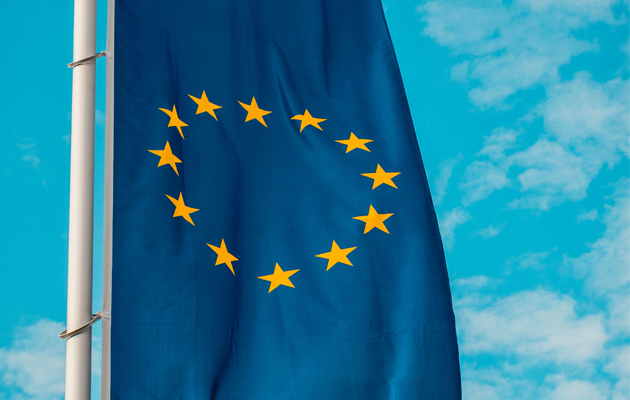
Peter Smisek takes a timely look at the flag of the European Union and its role representing a bloc of very different nations
All flags are venerated in their homeland, but only a few manage to achieve international notoriety. Some, like the Union Jack and the Stars and Stripes, are globally recognisable, courtesy of their respective nations’ imperial(ist) projects in the 19th and 20th centuries. They have their own nicknames, as well as adorning everything from t-shirts to cars and refrigerators. The European flag might be a little less shouty than either of these, and has no catchy sobriquet, but by virtue of representing a more-or-less united bloc of 28 (soon to be 27) very different nations, it can still claim to be an instantly recognisable symbol.
Although now indelibly linked to the European Union, the familiar circle of gold stars on a blue background was first used in 1955 as the symbol of the Council of Europe (CoE), an international organisation founded in 1949 that is still active today, and whose aim is to promote and uphold democratic values and the rule of law across Europe.
Read more: OMA on Brexit and the future of the European Union
Credit for the flag’s design is given to Paul Lévy, a Belgian Holocaust survivor who became information director at the CoE, and Arsène Heitz, a French designer and devout Catholic. Following Expo 58 in Brussels, the CoE began lobbying other European organisations to use the symbol, and its efforts eventually culminated in the EU’s precursor, the European Community (EC), adopting the flag as its own in 1985. This wasn’t the only piece of representative symbolism that the EC appropriated from the CoE that year – it also picked up Beethoven’s 1823 Ode to Joy, which the Council had designated as the Anthem of Europe 14 years earlier.
But the circle of stars has proven controversial: Lévy liked to claim that he designed it on his own and that Heitz was merely a designer of many failed alternatives, while Heitz retaliated by saying that the 12 stars were drawn from his Roman Catholic beliefs – specifically the crown that the Virgin Mary is often depicted wearing, which also has 12 stars. The suggestion that the European flag reflects the continent’s Catholic heritage may be politically unfortunate, but it is unsurprising: even in 2015, more than 45 per cent of Europeans were nominally Catholic, as opposed to 11 per cent Protestant, and 15 per cent other Christian denominations. In 2017 French leftist presidential candidate Jean Luc Mélenchon lambasted the EU flag as a ‘sectarian symbol’ that in his view should not hang beside the tricolore in the country’s National Assembly.
It is easy to see the European flag as a symbol of the EU’s complex and at times opaque machinery – and almost all of the EU’s many bodies and institutions use the flag’s colours and stars with gusto, some more deconstructed, some less so. But the flag has also become a symbol of European cooperation, solidarity and democracy. At a time when these values are under threat, both from within and outside the EU’s borders, the flag has become a shorthand to some for socially liberal values and the accountability of state power. It featured in the Euromaidan protests in Ukraine, in marches against the illiberal democracies of Poland and Hungary, and albeit to a lesser extent, even during anti-corruption protests in Slovakia and Romania. For many in these countries, the European project remains attractive.
With the UK’s exit from the EU now imminent, the European flag has become a symbol of the 48 per cent of British voters who supported their country’s continued membership. It now takes pride of place alongside the Union Jack – lest remainers be branded cosmopolitan traitors – during anti-Brexit marches.
The flag’s relatively straightforward design has been a boon to even the most high-profile of protestors. London mayor Sadiq Khan’s lighting scheme for the London Eye last New Year’s Eve was perhaps the most overt example, although even the Queen was accused of wearing an EU flag-themed dress and matching hat for the Queen’s Speech in 2017, albeit the yellow ‘stars’ were in fact cornflowers made of taffeta.
The flag has also been a godsend to lazy art directors everywhere – to refer to Brexit, you only need to leave one of the stars off. In reality, the constellation never reflected the number of states in the EC, EU or indeed the CoE. According to the EU’s website, the number represents ‘perfection and entirety, like the 12 apostles, 12 months of the year, 12 signs of the zodiac’. Without Britain, the EU will be able to continue its pursuit of an ever closer union, and even if more countries were to leave, or indeed new ones were to join, the number of stars will remain unchanged.
The question is: will the UK’s own flag, which combines symbols for England, Scotland and (Northern) Ireland, also remain unchanged when Brexit is done?
This article originally appeared in Icon 190, the April 2019 issue.

















